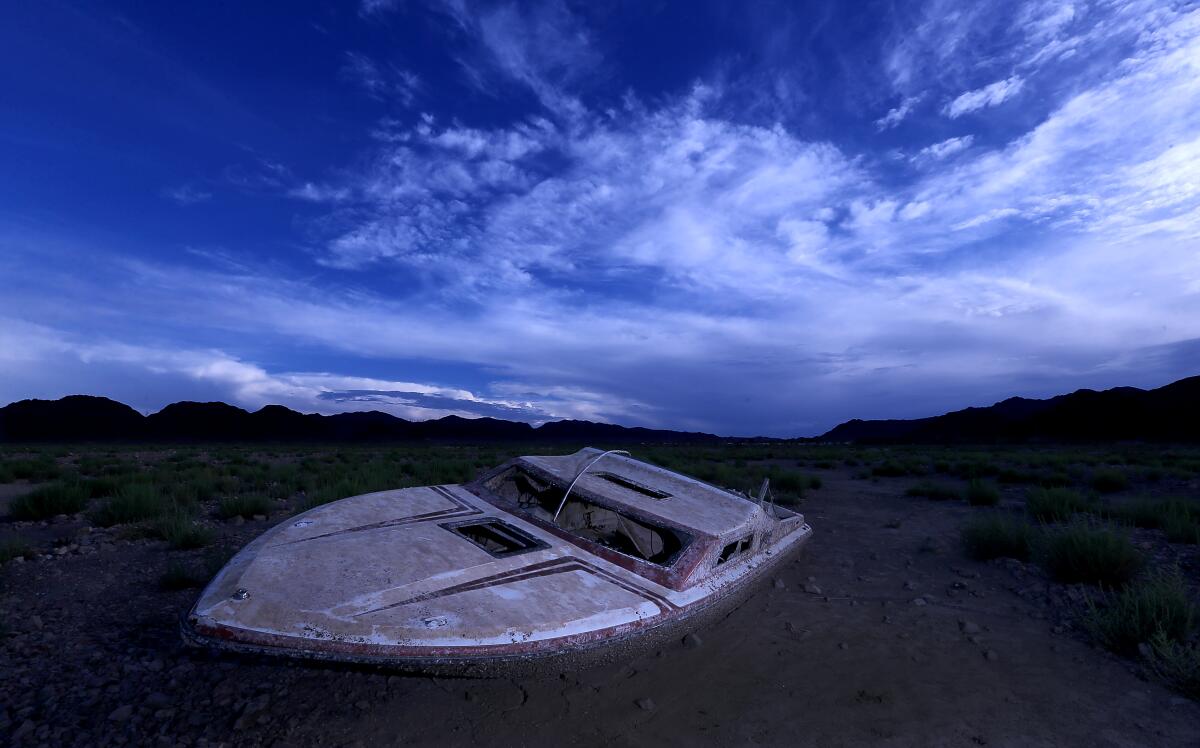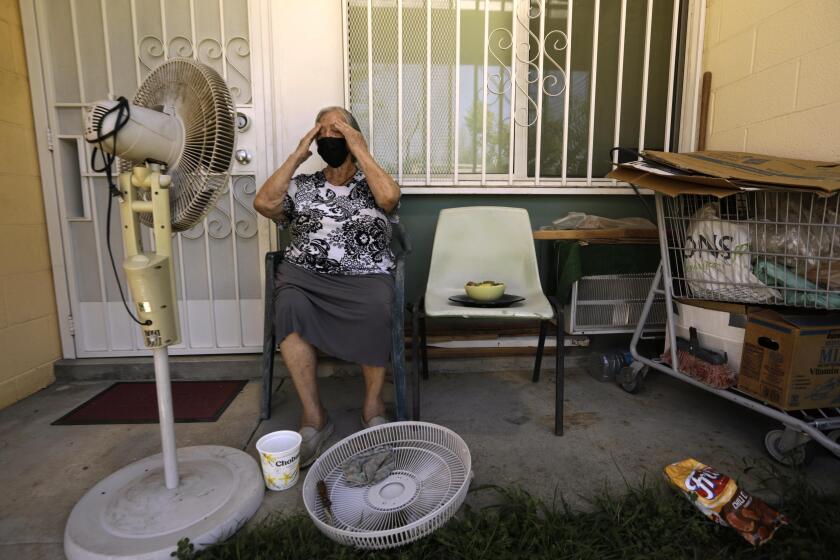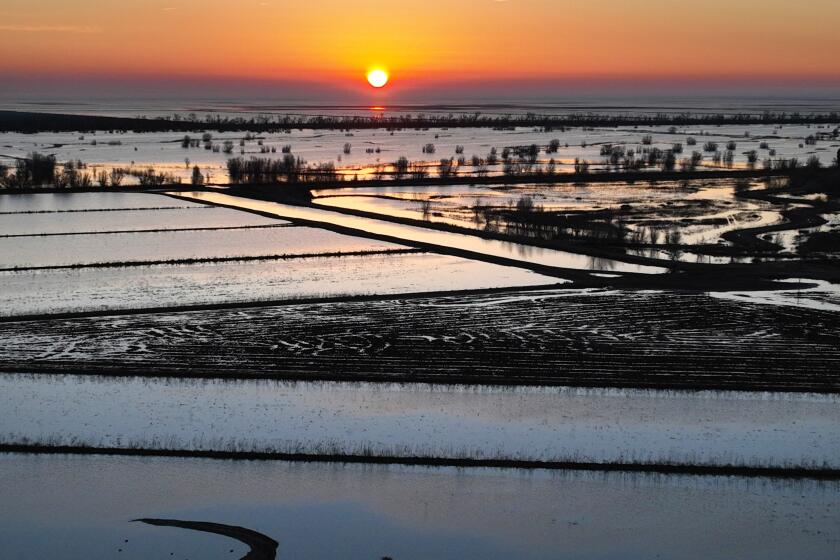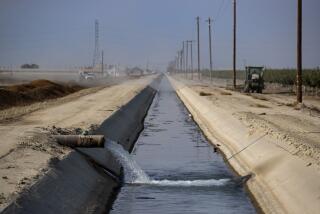Amid conflicts and climate change, U.N. puts focus on ‘deep trouble’ in water worldwide

- Share via
For the first time in 46 years, the United Nations convened a global conference on water, creating new impetus for wide-ranging efforts to manage water more sustainably, adapt to worsening droughts and floods with climate change, and accelerate solutions for the estimated 2 billion people around the world who live without access to clean drinking water.
The conference this week in New York brought together about 10,000 participants, including national leaders and scientists, with a focus on addressing the world’s many water problems and making progress toward a goal of ensuring clean drinking water and sanitation for all people.
“Water is humanity’s lifeblood,” U.N. Secretary-General António Guterres said. “But water is in deep trouble. We are draining humanity’s lifeblood through vampiric overconsumption and unsustainable use, and evaporating it through global heating. We’ve broken the water cycle, destroyed ecosystems and contaminated groundwater.”
Governments, nonprofit groups, businesses and other entities made hundreds of commitments in what the U.N. called a Water Action Agenda, with pledges as diverse as addressing scarcity in water-stressed regions and cleaning up lead-contaminated drinking water. Countries including the United States and Japan pledged to spend billions of dollars helping to improve water infrastructure.
The report focuses on how the world can better adapt to the accelerating effects of climate change to reduce risks and protect vulnerable people.
The conference also prominently featured discussions about nature-based solutions, such as restoring river floodplains and coastal wetlands, and dismantling concrete flood-control channels to allow stormwater to recharge aquifers.
Leaders discussed strategies for adapting water management to become more resilient as climate change melts glaciers, raises sea levels and intensifies droughts and floods. With most natural disasters linked to water, U.N. officials said reducing risks should be an urgent priority.
As water scarcity has worsened in arid regions, violence over water has been on the rise.
Peter Gleick, a climate scientist and co-founder of the Pacific Institute, presented research showing that over the last two decades water-related conflicts have grown increasingly frequent, with more violence erupting over access to water in India, Iran and other countries in the Middle East and Africa.
“No region of the world has been immune from the risk of violence associated with water resources,” Gleick said.
“There is growing competition for water. Populations are rising. Economies are expanding. Demands for the fixed amount of water on the planet [are] expanding,” he said. “There are inequities, major inequities around the world, in who has access to and control of water resources. That contributes to tensions.”
Gleick and other researchers have for years tracked data on water-related conflicts, including incidents in which water is a trigger of violence or is used as a “weapon,” or in which water systems are affected by violence. They also have researched strategies for reducing conflicts.
Conflicts over water have erupted between farmers and city dwellers in India, and between farmers and herders in Kenya. Recent examples have included killings of farmers in disputes over water in Pakistan, and a protest in Iran that ended in violence when farmers rallied in a dry riverbed to demand the government address shortages.
In regions already plagued by poverty and violence, crises triggered by water — whether floods, droughts or scarcity — have displaced growing numbers of people who have left and migrated elsewhere.
About 40% of the world’s population is affected by water scarcity, according to the United Nations, and demand for water continues to grow.
The effects of climate change are adding to the pressures, Gleick said, and “a lot of the places where water conflicts occur are places with weak management.”
Scientific research has shown that with rising greenhouse gas levels, the changing climate is intensifying the water cycle and causing more extreme droughts and floods.
In the American West, researchers have found that rising temperatures worsened more than two decades of drought and have contributed to a 20% decline in the Colorado River’s flow since 2000.
Using satellite measurements, scientists have found that groundwater is being rapidly depleted in many food-producing regions around the world, from India to the western United States, and that many dry regions have grown drier.
“The pace and the scale at which things are happening are unprecedented,” said Jay Famiglietti, a water scientist and professor at Arizona State University’s School of Sustainability.
In regions around the world where groundwater is being heavily pumped and depleted, he said, improving management will be crucial for continued food production and preserving aquifers for the future.
Excessive groundwater pumping has long been depleting aquifers in California’s Central Valley. Now, scientists say the depletion is accelerating.
Famiglietti said he thinks the world should move toward a global framework for water similar to the Intergovernmental Panel on Climate Change and its targets for reducing emissions of carbon dioxide from the burning of fossil fuels.
“We need to have some overarching guidance,” Famiglietti said, “that countries need to begin committing to reducing their groundwater use or being more efficient, and thinking about their long-term groundwater supplies and how they will be sustained.”
Because companies — and in particular the food industry — account for a large share of water use, Famiglietti said, they also have key roles to play. He said the discussions at the U.N. conference showed that “corporate water stewardship has emerged as a key priority at the C-suite and board levels.”
The conference opened on World Water Day on Wednesday and ended on Friday. The first U.N. Water Conference was held in 1977 in Argentina.
Since then, Earth’s population has more than doubled and water consumption has dramatically increased, putting stresses on resources that are projected to continue growing.
“We have to really revalue water and start to manage and organize and govern it totally differently,” said Henk Ovink, the conference co-chair and the Netherlands’ special envoy for international water affairs.
Ovink said that “institutionalizing water security is going to be of critical importance for the world” and that the commitments by countries, companies and organizations will propel actions toward a “water-secure future.”
Ambika Vishwanath, a water expert and director of Kubernein Initiative in Mumbai, said water management needs to change in India and other countries to prevent overuse and prioritize the protection of resources.
“We have to think about where it’s coming from. Is that water resource also safeguarded for the future?” Vishwanath said.
She said protecting the source watersheds, including rivers as well as groundwater, is vital because “that access will one day disappear if we haven’t thought about the other side of that pipe.”
In parts of California’s Central Valley, farmlands are being used to soak up storm water and replenish depleted groundwater.
Many at the conference spoke of a need to work with nature to manage water, including by restoring healthy ecosystems in floodplains, wetlands and forests.
“Nature-based solutions are a great option, because they’re a softer option and less intrusive,” said Leslie Duncan, senior Aboriginal consultant with Alluvium Consulting and chief executive of Economic Participation of Indigenous Commu- nities in Australia.
“The hard solutions of steel, cement and damming are not necessarily the right solutions,” Duncan said. “So we need to turn our minds to thinking about Mother Nature, and how we can look at those nature-based solutions that can deliver.”
Participants also discussed the role of Indigenous people in governing shared water resources.
Duncan, of the Kamilaroi Aboriginal people, said that inclusive governance is vital in deciding how water is allocated and that Indigenous people’s traditional knowledge about agriculture and other subjects can provide critical guidance for sustainable water practices.
“In Australia, Indigenous people have coexisted on the driest inhabited continent on the planet in a symbiotic manner,” Duncan said.
“A lot of water knowledge is with our Indigenous women globally. And the term that we’ve introduced here, from Australia, is the rematriation of that knowledge,” Duncan said.
“The climate change issue is here. It’s every day. So we need to look at the type of technology and the water infrastructure that’s going to deliver, that can stand the pressures,” Duncan said. “We will be judged by our next generation on the state of the environment and the type of society that they’re going to grow into.”
The U.N. secretary-general said the commitments made at the conference “will propel humanity towards the water-secure future every person on the planet needs.”
He said key priorities include reducing pressures on water resources and developing alternative agricultural systems to address unsustainable overuse of water in food production. Leaders also agreed to create a new global water information system by 2030.
Felicia Marcus, a water researcher at Stanford University, said she hopes the conference will lead to a burst of action to move toward the U.N.’s Sustainable Development Goal 6 — ensuring access to clean water and sanitation for all, which the world body has enshrined as a fundamental human right.
“Let’s hope it was more than a water talk fest, and that something comes out of it,” Marcus said.
“The top of the list is really accelerating work on the human right to water and getting clean water and sanitation to everyone in the world,” she said. “That’s not impossible to do. But it requires focused effort.”










